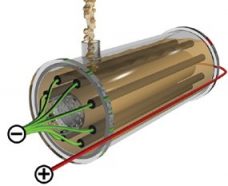Drawing energy out of wastewater
Microbes in a fuel cell can generate electricity from plant and animal waste in water.
By Emily Sohn
Flush. Every time you go to the toilet, your waste gets carried away by water. Before it can be released into the environment, the wastewater has to be treated to remove solids and other contaminants.
Now, environmental engineers from Pennsylvania State University have found a use for all that waste material—as an energy source. Using a type of energy generator called a fuel cell, they can break down plant and animal, or organic, waste and, in the process, produce electricity. Their technique could reduce the cost of treating water.
 |
|
As wastewater flows through this new type of fuel cell, microbes break down organic matter and release electrons, which flow from the negative electrodes (green) to the central positive electrode (red).
|
| T. Schindler/National Science Foundation |
Once you flush the toilet, you probably forget about whatever you just dumped in there. Every year, though, the United States alone spends $25 billion to clean up sewage. Many countries can’t even afford to treat their water.
The new fuel cell is a small plastic cylinder. Inside, eight rods made of graphite (the black stuff that’s in a pencil) act as negative electrodes. The rods surround a hollow tube made of carbon and platinum, which acts as a positive electrode.
When wastewater is pumped through the fuel cell, bacteria already present in the water stick to the graphite rods. As the microbes break down the organic matter in the water, they generate electricity.
Current water treatment techniques are expensive because they use bacteria that need a steady supply of oxygen. The new process could be more efficient, equally effective, and much cheaper, the researchers say. With improvements, such a fuel cell could provide enough power to pump an entire community’s sewage.
Talk about powerful poop!







